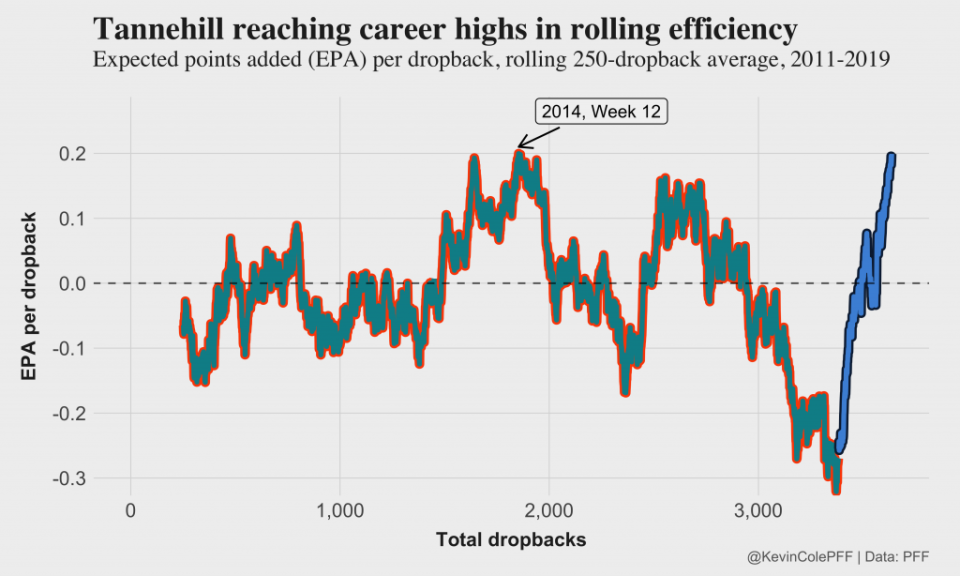Is Ryan Tannehill truly the Titans' QB of the future? There's compelling data that says yes
By Kevin Cole
To say Ryan Tannehill has been a pleasant surprise for the Tennessee Titans would be a vast understatement. The Titans are 6-1 in Tannehill’s seven starts and firmly in the playoff race.
But what the Titans’ new signal-caller has provided to the offense goes well beyond QB wins. Tannehill ranks first among quarterbacks in three of PFF’s critical passing factors: clean pocket, standard dropback and no play-action passing. These are the more stable measures of passing, which points to continued success. He also leads all passers in the percentage of positively graded dropbacks and is sixth in avoiding negatives.
Tannehill has been nothing short of a revelation, and the Titans are reportedly discussing a long-term deal to keep the good times rolling. Despite how good Tannehill has looked, we’re still talking about a sample size of only 250 dropbacks. That’s a relatively short run of success that followed more than 3,000 career dropbacks with the Miami Dolphins that inspired so little confidence he was sent packing for a pittance.
Here’s a numbers-heavy analysis to figure out if we can trust that Tannehill will continue to play at a high level, or revert back to his mediocre play of the past.

Looking at Ryan Tannehill’s past
What we're seeing from Ryan Tannehill this season appears to be a breakout. He had similar flashes with the Dolphins.

Tannehill had an up-and-down career in Miami, ending at his lowest trailing efficiency before being traded to the Titans. You can see that Tannehill’s trailing efficiency was even slightly better than now during the middle of the 2014 season.
Tannehill has been excellent of late. He has also done it before and then faded back to earth.
How Tannehill has benefitted from Titans’ scheme
Using passing game clustering developed by PFF data scientist Timo Riske based on route data from 2014-2019, we can assess the difference between the passing schemes Tannehill has operated under during his career.
Tannehill’s early passing scheme under Joe Philbin (2014-2015) featured more short passes, short-middle passes, passes to the backfield, and screen passes, which makes sense since Philbin is a West Coast offense devotee.
The offenses that Tannehill ran under Adam Gase (2016 and 2018) had passing game schemes similar to those of Titans offensive coordinator Arthur Smith, but to a lesser degree. These passing games feature a higher degree of play-action and routes occupying the deep middle of the field.
The 2019 Titans offense is similar to the 2017-2019 Rams, coached by Sean McVay. Tannehill is now thriving in a scheme that turned Jared Goff into one of the most efficient passers with the support of strong receiving talent and pass-blocking, which Tannehill now enjoys in Tennessee and didn’t always in Miami.
Tannehill is leveraging play-action, still taking too many sacks
We also see differentiation in the Titans’ passing scheme in play-action usage, timing and depth of target.
Tannehill is using more play-action in neutral-game-script situations (within two scores and outside ends of halves) this season, with only Goff, Lamar Jackson and Kyle Allen at higher rates.
The increase in play-action passing has extended Tannehill’s time to throw, but more important, it has come in conjunction with an increase in depth of target, as his receivers have more time to get downfield.
But Tannehill’s Achilles heel this season, if there is one, is the value he loses when he takes sacks. Tannehill ranks last among 31 quarterbacks with at least 250 dropbacks this year with a sack rate of 9.8 percent.
What’s confusing is that his pressure rate this year has been one of the lower in the NFL. Since pressure rates are stickier than sack rates, there’s a chance Tannehill’s sack number improves. But taking sacks has been a longstanding issue for Tannehill.
What’s different about this season for Tannehill is that he’s offsetting the negative of taking sacks with the positives of maximizing the offense and throwing downfield when he isn’t sacked. Now the risks of his game are combined with commensurate rewards.
Is Ryan Tannehill the answer for the Titans?
Coming into this analysis, I thought the pure statistical measures would carry the day, sounding alarm bells and confirming the expectation that Tannehill will regress to his mediocre self.
But as I looked more into the Tannehill’s fit with the Titans, I was swayed by the potential for continued success in a scheme that has turned flawed quarterbacks like Goff into league leaders in efficiency when surrounded by talented receivers and blockers.
Tannehill has never had problems throwing the ball well; it’s one of the primary reasons he had such high PFF passing grades early in his career. The issue has been his ability to elevate a supporting cast and play in systems that complicate reads, like Philbin's West Coast system.
Tannehill may have found his match with the Titans. If that’s the case, you can see his recent performance as an indication that he’ll continue to produce at the higher end of his range of outcomes. Even with expected regression, Tannehill is poised to remain a top-10 quarterback.
For more deep statistical analysis, go to PFF.com
More from Yahoo Sports:

